#triantha
Text
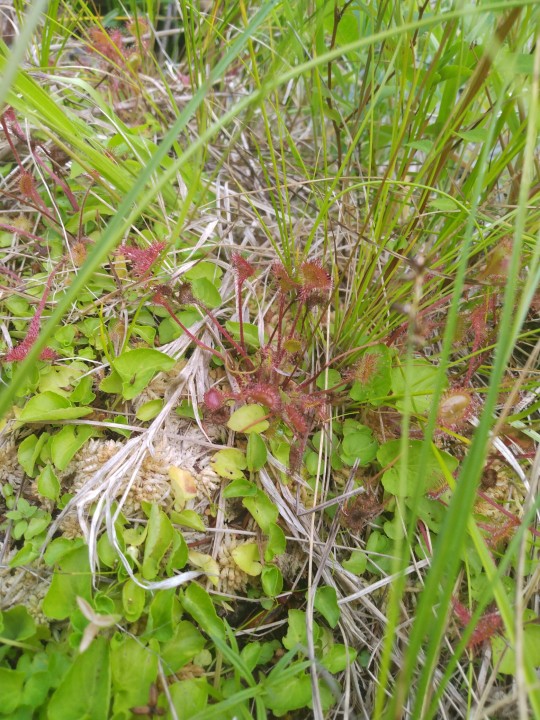

found wild carnivorous plants and wild sphagnum and i identified the triantha occidentalis (red buds in the 2nd picture) correctly without knowing what the plant looked like i only knew the stem was sticky. oh bitch you wish you were me
#its only carnivorous on the flower stalk and only eats bugs when flowering!#drosera#carnivorous plants
7 notes
·
View notes
Photo
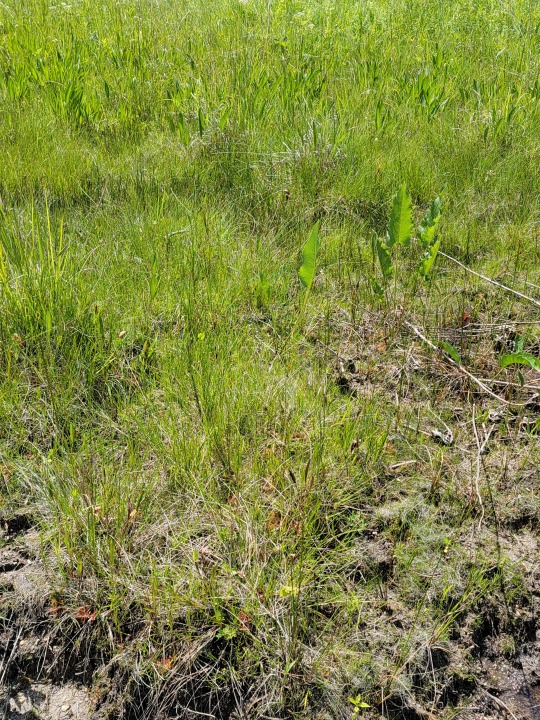
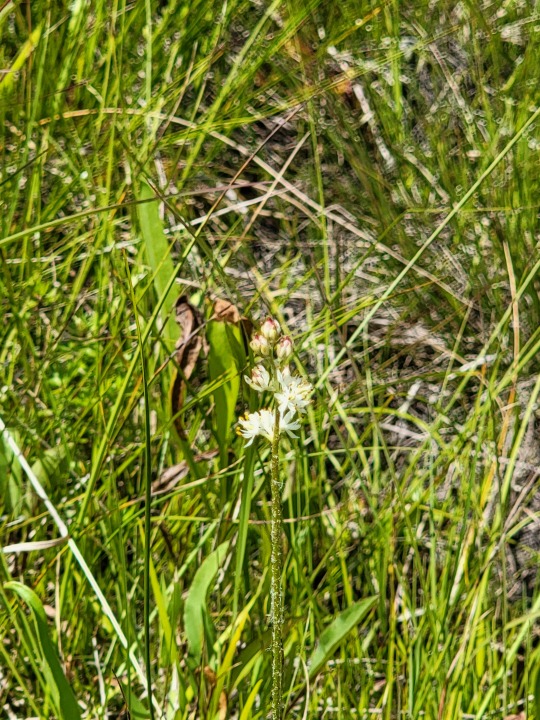




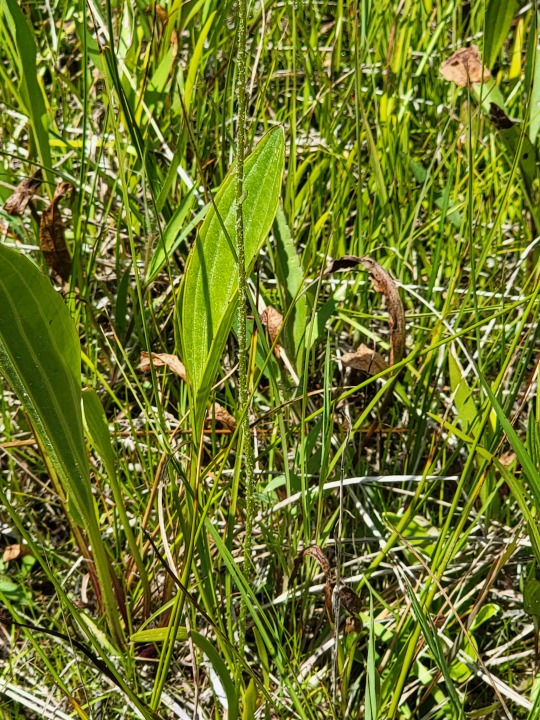
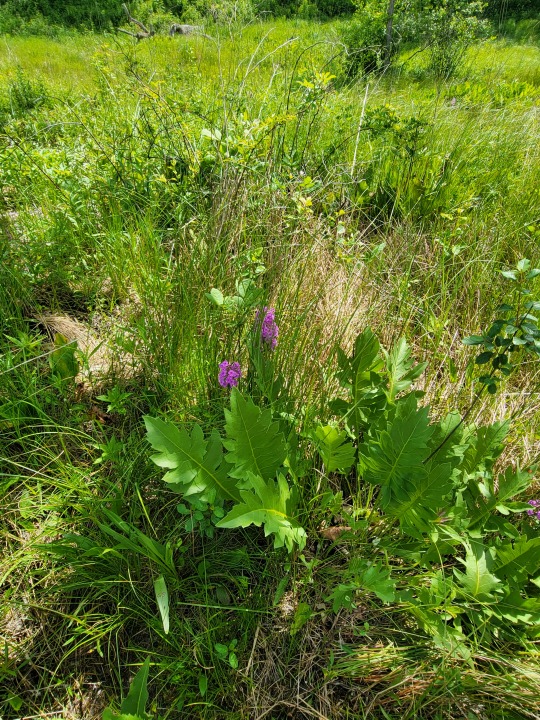


Denizens of the Marl,
My main focus was to introduce an early blooming species that I don’t know if I talked about ever. I usually miss my window to see this plant and for some reason I’ve never gotten close enough to photograph it properly, you can kinda see a gleam of light on the glandular hairs but not well enough to show structure.
Triantha glutinosa, blooms in early June in Ohio but can last till late June and in other states occurs in bogs in warm water conditions and blooms much later which is strange to me. I think this must be an adaptive phenotypical thing but you would expect it to be opposite and light blooming also seems to not be the culprit so I don’t know. False Asphodel is another common name but I honestly prefer calling it sticky or glutinous false ashpodel. As a plant living in these nutrient poor super leached marl flats this plant is a carnivor, protease excretor glandular hair trap specifically, but strangely only on it’s flowering stem and not on it’s minute basal rosette. Opposite of most species that are carnivores most species try to keep traps as far from the flowers as possible which makes sense evolutionary. Glandular traps near an inflorescence seems strange for successful pollination. As it turns out this may be a seldomly pollinated species where most individuals in populations are ancient clones that have formed from rhizome spread overtime in these glacial refugium. The other thing that seems notable is many people studying these false ashpodels (Triantha spp.) run into the same morphology and phenology problems that I have, and have even come to contempt and discourse over specific populations and are evaluating them as part of a biological species complex. I agree on the T. occidentalis western split on all accounts but some of the minor disjunct probable splits seem more complex overall (Central Appalachian mountain populations (TN, VA, SC, GA)
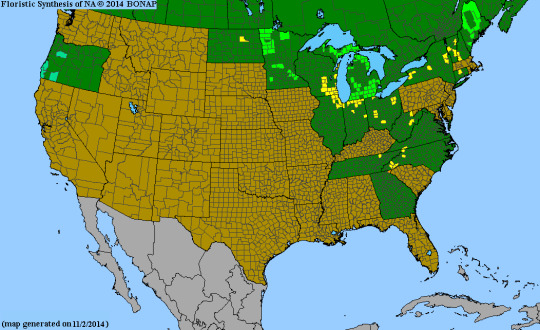
I feel like I can’t stress the importance of this limestone marl and the unique opportunity of getting this close to these plants without any special camera. Though I do wish I had one to display the features properly. Most of the time if you are traversing a fen you have to find and identify petrified marl shelfs or surface travertines, or you are walking on old and ancient tussock clumps from what is usually Carex stricta. Im walking on a displaced gravel shelf with petrified marl and wouldn’t dare to walk off of it and disturb the easily motile banks of loose marl or the suspended marl sediment floating like quick sand. The plants here are fragile and the habitat is equally fragile with many state listed species that cant take damage. Everywhere in the high exposure areas of marl flats are these Drosera rotundifolia and the smooth rounded/heartshaped leaves of grass of parnassas, which is in bloom as I type. Parnassia glauca is so beautiful with it’s unique floral venation and Ill post more pics once again when I get to it. The farther you get from the flats the less exposure and with it comes the sedge meadow with Arnoglossum plantagineum, also known as fen plantain leaved indian plantain. The last few shots are associated with the fully scabrid moderate sized var. ,not species, Silphium terebinthinaceum var. pinnatifidum, which we only see in fens in Ohio and the Ice scoured dwarf willow, Salix myricoides, in all of it’s new leaf glory. Still not looking blue with white pubescent undersides just yet.
Personal note:
Its been really weird doing this lagged posting because these are not matched to the time I was there. Right now, I feel like I should be posting about white bottle gentian, prairie gentian ,fringed gentian or ,andrews bottle gentian and here I am mid June posts. Heck it’s also Spiranthes spp. season and paw paw shaking season rn, most people are smelling sulfur shelves and foraging chicken of the woods(same thing). Trying to catch up and doing documentation and having a place to post personal thoughts on this stuff.
#fens#meadowcore#silphium#salix#salix myricoides#arnoglossum#arnoglossum plantagineum#species complex#carnivourousplant#carnivory#botany#ecology#wildflowers#ohio news#ohio#kawaii#plantblr#botanical#botany on tumblr#plants on tumblr#plants#drosera#drosera rotundifolia#geology#cottagecore#parnassia#parnassia glauca#triantha glutinosa#triantha
24 notes
·
View notes
Text
Tombee vs Crumbs, a naming war
Recently, one of our (kind-of) persecutors (X) came out of his voluntary dormancy for no visible reason. He was very angry about being dragged back into consciousness, but there was nobody he could really blame, so after some aggressive pestering from everyone he decided ‘fuck it, guess I’ll try existing for once’
Thus, X went to Walmart to become inspired to do something besides mope and seethe for once
He didn’t find much, so it was a pretty boring time, but just when he was about to give up, he sees it: a flash of yellow and brown stripes down an aisle of plushies. He goes to pick it up, and he finds out that it is a gigantic minecraft bee. Yes, he thinks. This is what I came here for.
On the way home, though, he tries to think of a name for it. He is very particular about names, so it can’t be something stupid like Bob or Larry.
Finally, he decides upon the name Tombee.
Fast forward a couple days, and Mackenzie is fronting, and she loves the plush. The only thing about it was that she didn’t like the name Tombee, and so she decides she will call it Crumbs.
X is absolutely furious about this, especially because every other headmate also calls it Crumbs. It was his plush first, after all, and he was technically the one who earned the money we used to pay for it, so he should logically get to name it. Everyone else sort-of agreed with this, but they also agreed that Tombee was a terrible name. X admitted that he also didn’t like the name very much, but that he had felt backed into a corner by everyone else collectively choosing a different name. So he finally relented on the condition that he was the one who got to choose the new name. Everyone thought this was fair.
Finally, he stuck with the name ‘Triantha’, named after a genus of plant which includes the false asphodel, a carnivorous flower
0 notes
Text
イワショウブ イワショウブ の特徴と育て方
● イワショウブ イワショウブの品種の特徴
「イワショウブ」は細い葉の形が菖蒲の名が付きました。湿原や水分の多い場所を好んで自生しています。別名のムシトリゼキショウは茎に生える綿毛が粘ることにちなんでいます。
学名
Triantha japonica チシマゼキショウ科 イワショウブ属
別名
岩菖蒲、ムシトリゼキショウ
開花時期
7~9月
花色・大きさ・花形
白色・・一重
最終樹高
地植え:0.2m ~ 0.4m 鉢植え:0.2m ~ 0.4m (多年草)
栽培用途
鉢植え、地植え、花壇など
育てやすさ
★★☆☆☆ やや難しい
日照条件:日なた~半日陰、
耐寒性普通、耐暑性やや弱い
耐病害虫性
耐病性:強い 害虫:ほとんどつかない
花言葉
感謝、誠実
イワショウブ…
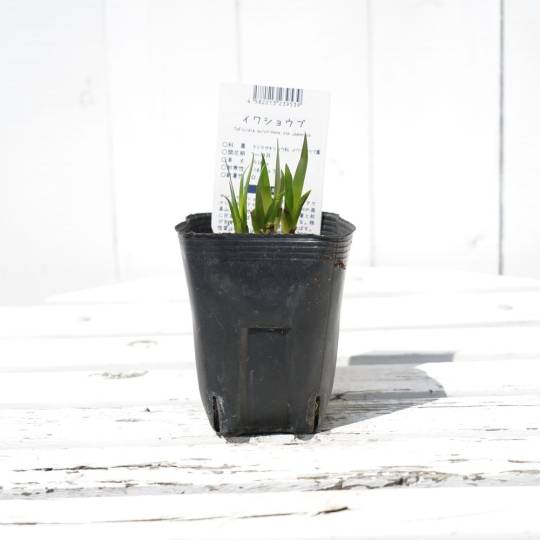
View On WordPress
0 notes
Photo
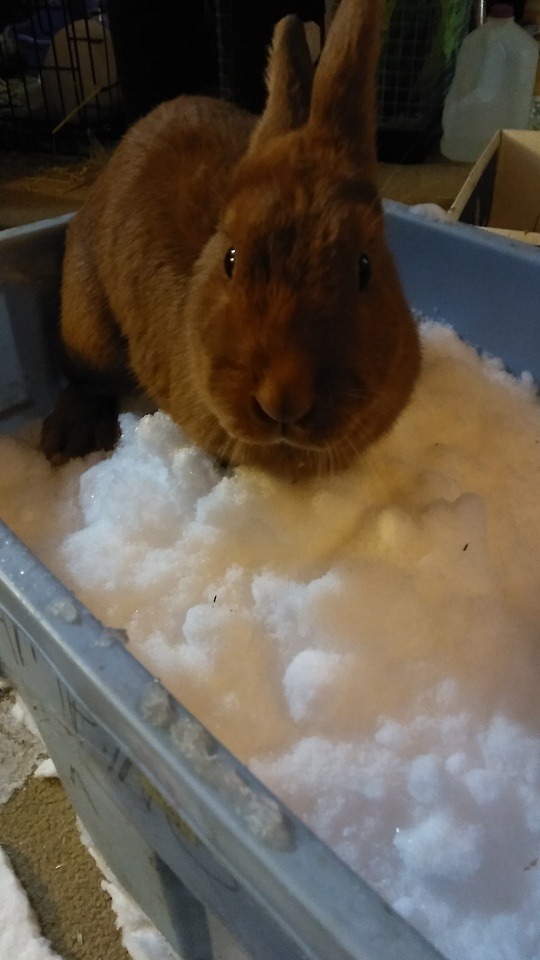
I brought some snow inside for the bunnies to play with. Here is the Caramel bunny.
74 notes
·
View notes
Photo
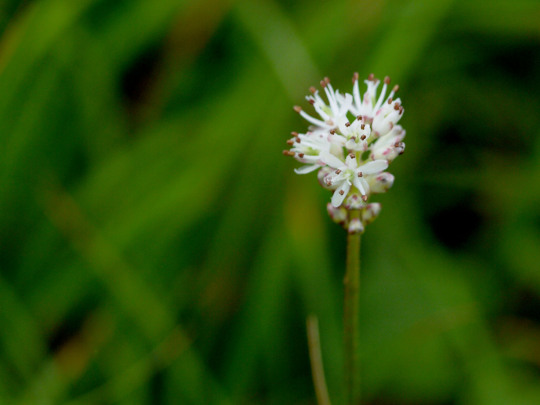
Triantha japonica イワショウブ
#Triantha japonica#イワショウブ#alpine wildflowers#gassan#july#yamagata#japan#original photography#月山#弥陀ヶ原#湿原#湿原植生#山形
4 notes
·
View notes
Text
heard the news?

“A pretty little white flower that grows near urban centers of the Pacific Northwest turns out to be a killer. The bog-dwelling western false asphodel, Triantha occidentalis, was first described in the scientific literature in 1879. But until now, no one realized this sweet-looking plant used its sticky stem to catch and digest insects [...]. [I]t’s the first new carnivorous plant to be discovered in about 20 years. [...] Fewer than 1,000 plant species are carnivorous [...]. All the other known carnivorous plants capture prey with the help of modified leaves [...]. “Nobody would be looking at a flower stalk as the primary mode of carnivory [...].” The whole experience has left Graham [botanist at University of British Columbia, lead researcher of the project] wondering what else is out there secretly eating insects. After all, it’s not that uncommon for plants to have sticky stems [...]. “I suspect,” Graham says, “that there might be more carnivorous plants out there than we think.” [Source: Nell Greenfieldboyce. “This Sweet White Flower Is Actually A Sneaky Carnivore, Scientists Discover.” NPR - All Things Considered. 9 August 2021.]



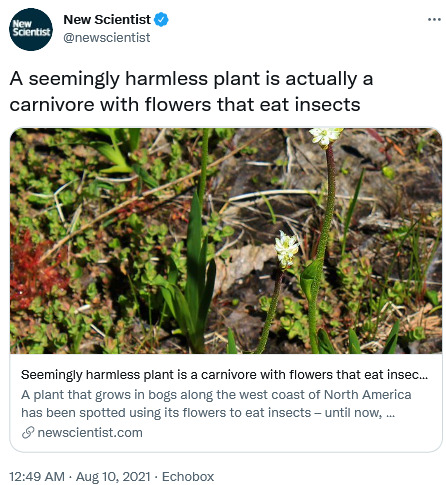
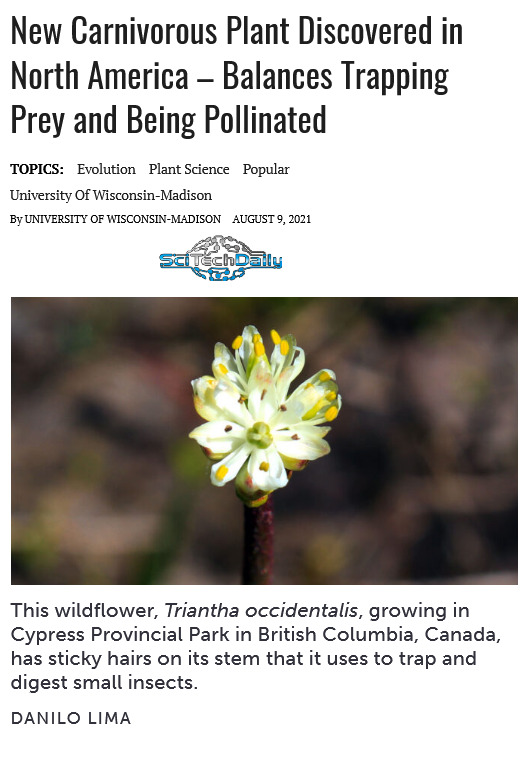
From NPR, 9 August 2021:
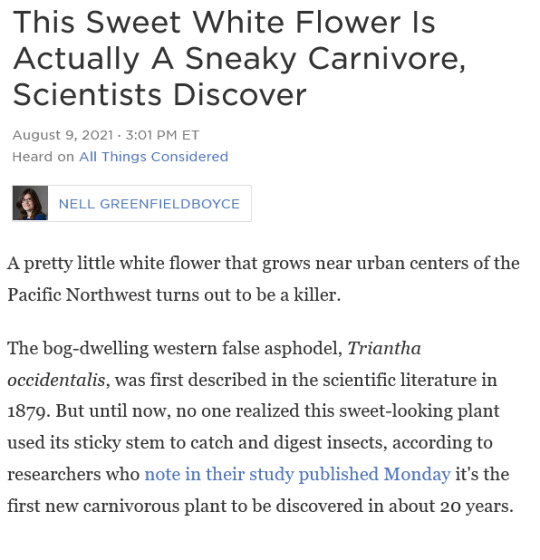

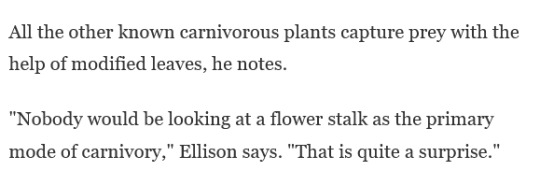
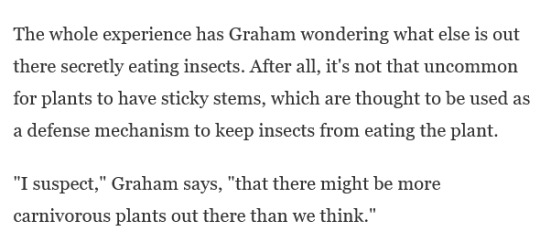

5K notes
·
View notes
Text
Asphodelus.
Ectoberhaunt: Flytrap
AO3 | tags: hinted character death(s) , Nature is Metal
Summary: Amity Park imports new plant in hopes that it would withstand the damages caused by ghost attacks. Said plant thrives in Amity's unique blend of soil and environment. Perhaps too well.
--
It was a typical day when a certain truck containing new plants arrived in Amity Park. That in itself is ordinary enough, damages caused by ghost attacks render Central Park's plants dead every other day of the week. Initially it was simple enough to buy new plants from Amity Park's horticulture association to replace the ones torn apart from ghost attacks. However with the rate of destruction caused by ghosts they soon ran out of plants sold in Amity Park. Even so, they merely expanded to purchasing from Elmerton. It would've been easier to leave the park as is considering how often it ends up as ground zero for ghost attacks. There's an unofficial bet on which ghost would next grace the park with its presence. Let it never be said that Amity Park citizens aren't resilient. While they might not be able to fight ghosts head on like ghost hunters, they are determined to make sure that ghosts never leave any lasting impact on Amity Park. Call them stubborn but they won't let ghost attacks impact their lives.
It was inevitable that ghost attacks would leave enough ectoplasm spills to soak into the soil and thus Amity's ecosystem. After a while, plants refused to settle into Amity's soil. The soil is simply too acidic, too toxic for most plants. But Amity is stubborn. They will find a way to replant trees in the park.
Someone, probably someone from Amity's horticulture association, suggested introducing a new plant. Triantha occidentalis. Found in bogs, fens, and wet meadows along the West Coast, Triantha occidentalis thrives in low nutrient areas and acidic soil. The perfect candidate for ghost-infested Amity Park.
The suggestion received a stamp of approval in no time.
.
Not many people noticed the new plants right away though horticulturists and plant enthusiasts appreciated the addition. Gardeners certainly appreciated the hardy plant; it thrives in its new soil and didn't need extra fertilizer to keep it alive. It bounces back quickly from ghost attacks. It even appears as if the plants have grown even more beautiful in Amity's unique soil and environment. It's leaves glow vibrant green with life, its flowers strikingly white. Its tiny white buds joined other colorful flowers as part of Amity's flora.
.
When Danny heard his mom commenting to his dad about the drop in ambient ectoplasmic radiation, he hadn't paid much attention to it. The drop was just a minor blip which could be caused by plenty of factors like the approaching summer. Danny, well attuned to changes in temperature, could already feel the ambient rise in heat.
Another month passes by in a flurry of exam papers.
Reports of citizens seeing weird shadows in empty alleys and strange passageways have dropped. Not that anyone would notice without comparing their observations. The only group that might’ve taken notice, being the ones who took advantage of the special shortcuts, were too busy with their final exams to take note of the disappearing routes.
Another month passed with summer in full swing. It might be just the sunny skies and warm winds but everyone all agrees that Amity Park felt lighter. Like heavy dark clouds have been dispersed, allowing sunlight in. Even with imminent ghost attacks on the horizon, the cloying ominous feel is gone. Everyone smiled more.
.
The flowers bloomed. Warm gentle winds blew through Amity.
.
Danny feels lethargic. He sneezed. Red dusted his cheeks. He rubbed his nose with his free hand. Sam was capping the thermos while Tucker ran over to help Danny.
"You okay dude?" Tucker looked at Danny. Danny had fallen into a bush after failing to dodge Skulker’s latest missile upgrade.
“I’m fine Tuck, just caught a minor cold.” Danny sniffed. It was the first cold in a long while. The last time he caught a cold might’ve been before the accident. It was that long.
“Dude, it’s been two weeks since you caught this ‘cold’. Is there some sort of ghost flu going around?”
“I’ve already checked with Dora and Frostbite. There’s no rumors of ghost flu going around. It’s unlikely that there would be one in summer anyway, even ghost flu hates summer.”
Sam walked up to them, “ It might not be a ghost flu but we all know you’re not getting enough sleep. Get some rest Danny. Summer’s a low ghost season, we can handle the patrol. Plus we have Valerie now even if she still hates Phantom’s guts.”
“I’m fine guys.” Danny sneezed. Sam and Tucker looked at him dubiously. “With how much you’re sneezing, somehow I doubt you’re ‘fine’. You can’t even fight your way out of Boxy’s wet cardboard box.” Sam remarked.
Danny looked away to the side.
“... fine, I’ll get some rest.”
.
On bed rest, Danny found himself idling in the living room after finishing his homework (on time for once). The living room windows were left open to bring in fresh air. A pleasant scent brushed his nose. He ignored it but the longer he ignored it the more it became tantalizing.
He blinked and next thing he knows he’s staring at a tiny clump of white flowers.
“You like it Danny?” his mom asked.
Danny looked around. Somehow he had moved from the living room to their backyard. His mom was not in her usual jumpsuit for once, opting for a casual blouse and jeans, gloved hands holding a spade smeared with dirt. Small bags containing more white flowers lay next to her feet. The scent appears to be coming from the flowers. He inhaled more of its pleasant scent.
“Mhmm, yeah. It’s nice.” he nodded, leaning down to sniff it again. “Where'd you get these flowers from?”
“This? One of the neighbors gave me this. She said it's popular right now in Amity, very durable, very fast recovery from damages.” Maddie replied, replanting one of the flowers into the trench she dug next to the fence. “I thought it might be a good addition to our backyard.” They looked at their backyard, covered with random patches of black from experiment explosions.
After a moment, Maddie stood up and stretched. “So what brings you here?” she asked, smiling.
“.. it smells really nice.”
Maddie looked at him. “You have a good nose. I can barely smell it.”
“Smells like honeysuckle.” Danny said smiling.
His hand subconsciously reached out to touch the flowers. It felt tingly, in a nice way. He felt the tension (that he didn’t realize he had) in his shoulders loosen.
“I love it'', he said. He meant it.
“That's wonderful.” Maddie smiled.
She shifted a bit over to the side, “Here do you want to help me replant the rest of these?” she gestured at the plants.
“Sure” He didn’t have anything else on schedule for once so why not. It’s most certainly not because the flowers smelled nice.
It’s definitely his favorite flower now.
“What's it called mom?” he asked, taking the spade from her to dig up more shallow trenches for the flowers. Maddie paused, looking down at the bag of flowers in her hand.
“These? Hmm, I'm not too sure? The neighbor that gave them to me was calling them asphodels but they don't look like one.” she pointed at the flower buds, “See here? True asphodels have longer flower stalks. These look like tiny clumps of flowers densely packed together like balls of flowers. Also true asphodels don't have sticky flower stalks like this one.
They look similar though so maybe it's a relative?”
Danny looked at the flowers more closely, observing the flower petals. Its scent hits his nose. He felt like drooling. Odd, he thought. He tried to change his trail of thought, ignoring the strange reaction he got from the flower.
He looked back at his mom. “You sure know a lot about asphodels mom”
Maddie smiled proudly, “Of course. Did you know that asphodels were featured prominently in the Greek underworld? Your dad and I researched it for its possible connection to the ghost zone while we were designing the portal.” She placed the flower down in the dug up hole, using her gloved hands to pat the soil around the plant, “It's mostly just folklore though. There's only trace amounts of ectoplasm in it, barely higher than other flowers.”
Danny thought about the ghost version of asphodels. He does know about asphodels. Pandora has fields of it; it’s also grown in other areas of the ghost zone. Popular for its peaceful effects, asphodels are used for soothing the ache caused by unfulfilled obsessions. These flowers certainly aren't asphodels but they sure smell nice.
.
Later that night, Danny couldn't sleep. The flowers’ sweet inviting scent wafted in through the window. He couldn’t sleep so he might as well take a quick trip to the backyard.
Landing softly on the grass, Danny stood in stunned silence. The white flowers gleamed beautifully like jewels under the moonlight. Awestruck, Danny gently touched the petals with care.
Next thing he knew, he was chewing a flower bud in his mouth.
His first reaction was to spit it out. But he didn’t. It tasted as bland, a bit on the tangy side, but the scent! It's even more concentrated in his mouth! His core sang happily at the slight boost in energy.
Danny hazily floated back to his room in a happy daze. He flopped haphazardly on his bed, feeling very sleepy. That night was the first time in a long while that he slept without nightmares.
.
Ever since that night, whenever he wakes up from a nightmare or when he couldn't sleep, Danny would go into the backyard to snack on one of the flowers.
It didn’t go unnoticed. His mom remarked about the disappearance of the blooms, 'Jack? Did you accidentally blow something up in the backyard again?' Danny took to eating flowers from other places.
He tried collecting it, stashing it in his bedroom but it didn't taste as good when stale. The flowers made the room smell nice though.
.
The flowers in the Fenton's backyard grew back in no time. Maddie loves the flowers, it's the perfect match for their backyard that occasionally doubles as their testing area. It even blooms more once it has settled down in the new soil.
.
The green stains on their backyard have faded away. The stains were not easy to see under the green of the grass but it's plainly obvious when the stains glow at night like someone spilled glow in the dark paint in their backyard.
Now all that glows at night are the flowers under the moonlight.
.
Sam and Tucker didn't have any issues with ghosts.
They haven't seen any ghost since they forced Danny on bed rest. Wait scratch that. They did see Box Ghost but lost sight of him after he toppled a stack of crates on them. That was last Thursday. They still haven't heard any reports of Box Ghost sightings nor seen him since then.
Maybe Valerie took care of the ghosts before them? Tucker suggested. She had ghost radar and her jet sled could get her to places faster than they can even with their electric scooters.
Despite wanting to count it as a windfall, the lack of ghosts just sets them on edge.
.
On one of the nights where he stalked through the neighborhood for more flowers, Danny thought he saw a suspicious lump in one of the neighbors' patches of not-asphodel flowers. But there’s no lump in the flower patch when Danny checked them the following morning. Their flower patch sure looks beautiful. It smells very aromatic.
He noticed that some not-asphodel patches smelled nicer than others. His family’s flower patch, the park’s, and this neighbor's smell the best. The one on the school grounds also smells good.
.
His core craves more. It was tantalizing. Just a bit more.
The Fenton’s flower patch went wild, expanding beyond its original trench. Their backyard now looks more like a sea of white with some rare spots of green grass. Danny stared at the not-asphodels.
It looks very tempting. if only-
Danny shook his head. It's silly, he thought. That tempting thought of rolling in the flowers like a cat rolling on a patch of catnip was stuck in his mind for the rest of the day. He shook his head again trying to dislodge the thought and temptation. He mustn't. If only because Sam and Tucker would never let him recover his dignity if they saw him rolling in them.
.
Tonight’s moon shined just right, the flowers lit up under the moonlight like liquid silver lake.
Danny couldn’t help himself.
It smells
so nice
maybe
just maybe
a quick roll
no one will see
so sweet
so tempting
.
.
Sam and Tucker were camping out in the Fenton’s living room discussing Danny's latest disappearance (by the fifth time Danny got kidnapped, they just punched the kidnapper in the face before sucking said kidnapper into the thermos for a week-long timeout for the trouble).
They've bought some time by selling the Fentons a story of Danny going on a space camp (You signed his permission slip last month, don't you remember Mr. Fenton?). It took a bit of forging and some realistic camp brochures to convince the elder Fentons but it works for now.
It wasn't the Fentons who kidnapped Danny, they've checked. Tucker had installed a Foley™ program into the Fenton's security camera system. Normally Tucker would use it to remotely replace footage of Phantom using the portal with video footage of an empty lab but he can also use it to check in on the Fenton labs in real time like now. It's empty, no suspicious new inventions, no Danny.
“So…” Tucker started, “it’s not his parents. And the GIWs can't enter 15 miles around Amity Park after the lastest fiasco with Gregor/Elliot/whatshisname.”
Sam nodded, “And the ghosts are on radio silence. What about Vlad?”
The doorbell rang.
Sam and Tucker looked at each other. Danny’s parents are in the lab and Jazz never rings the bell. They nodded firmly in silent communication then cautiously crept up to the door to open it with Tucker hiding behind the door just in case. Then they saw the person behind the door.
"Vlad??", two voices echoed out in confusion.
Said man was decked in an industrial mask, complete with plastic pipe connecting the mask to an oxygen tank behind him. Sam snapped out of confusion first.
"What are you doing here?" Sam demanded.
But Vlad didn’t greet them with his patented smirk. He was frowning.
Without his usual fanfare, Vlad got straight to the point.
"Where's Daniel?"
---
Notes
Triantha occidentalis. More commonly known as Western False Asphodel. Found in bogs, fens, wet meadows, and small streams along the West Coast. A carnivorous plant that uses enzymes to digest insects caught on its sticky flower stalk. The flowers have no scent.
Yes this is a real plant.
All other strange effect it has on ghosts are purely fictional (tldr: the flowers mutated after exposure to ectoplasm)
--
(The flowers aggressively absorb ambient ectoplasm. In small amounts they’re harmless, but in big enough clumps they can eat up a ghost.)
(Danny, lured in by the scent, rolled in them.)
(The flowers have sedative effects on ghosts.)
28 notes
·
View notes
Photo
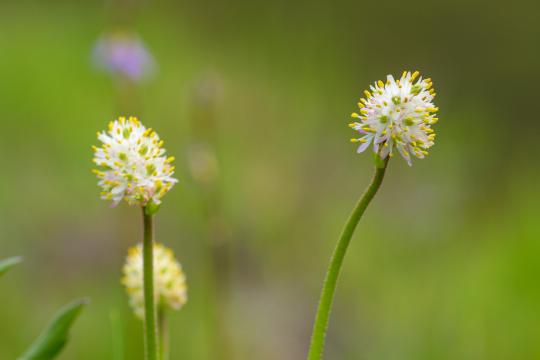
Montana’s “Newest” Carnivorious Plant - Triantha occidentalis (Western false asphodel)
7 notes
·
View notes
Note
Wake up friend new carnivorous flower just dropped: Triantha occidentalis

she's cute, good for her
7 notes
·
View notes
Photo

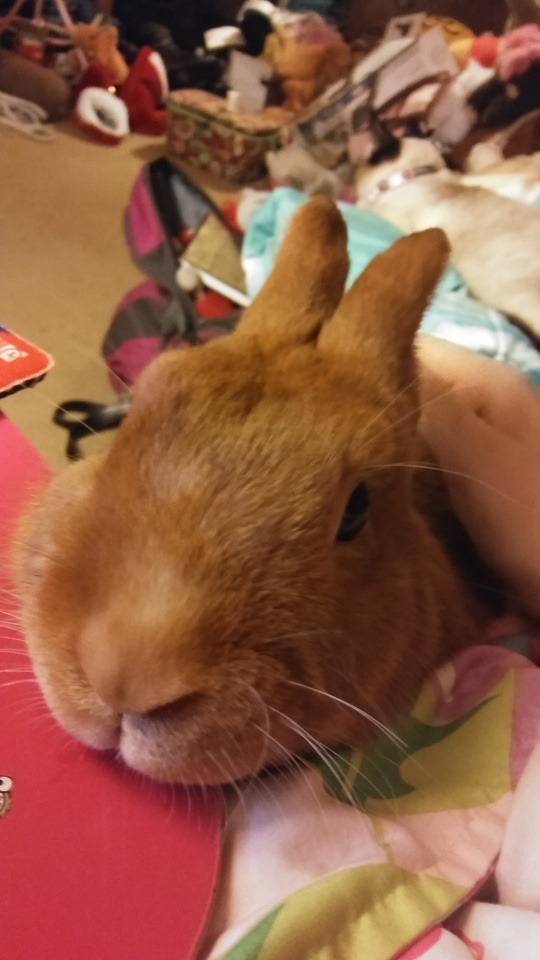

A sweet, cuddly bun
76 notes
·
View notes
Text
Well-known wildflower turns out to be a secret meat-eater
Gleaming, gluey, deathtrap hairs have just betrayed the secret identity of a well-known wildflower. It’s a carnivore.
This species of false asphodel looks like a harmless, white-petaled flower. But Triantha occidentalis has special, sticky hairs on its flowering stem. The plant uses its hairs to snare and digest insects. Scientists have known about the plant since the 1800s. But its taste for meat went undetected — until now. Researchers reported the finding August 17 in the Proceedings of the National Academy of Sciences.
Sticky hairs aren’t all that unusual. Many non-carnivorous plants use them to defend against pests, points out Sean Graham. A botanist, he studies plants at the University of British Columbia in Vancouver, Canada.
Experiments showed that Triantha occidentalis flowers are carnivorous. The plants get nutrients from insects caught on their sticky stem hairs (shown).Qianshi Lin
This plant has some qualities that other meat-eaters share. It lives in bright, nutrient-poor bogs. It’s also missing a gene that fine-tunes how plants get energy from light. Together, those features felt like pieces of a jigsaw puzzle hinting at a secret hunger for meat, Graham says.
To confirm that, Graham would need to know more. So he became part of a team looking for signs that this wildflower pulls nutrients from insect corpses. Luckily, T. occidentalis grows along North America’s West Coast, from Alaska to California. It can be found even on hikes near Vancouver. “They’re right on our doorstep,” says Graham.
The team started by feeding nitrogen-15 to fruit-flies. Compared to normal nitrogen, each atom of N-15 contains an extra neutron. And once flies ingest it, this tags their bodies with the heavy nitrogen. Next, the researchers attached the flies to the flowering stems of the bog-dwelling plants. Nitrogen-15 is not common in nature. But tests can scan for it and count how much is present in a sample of something — such as tissues of the wildflower.
More than half of the wildflowers’ nitrogen came from the fruit flies, not the soil, Graham’s group found. That amount is similar to what’s seen in carnivorous plants.
What’s more, the wildflowers’ sticky hairs oozed phosphatase (FAAS-fuh-tays). A digestive enzyme, it drives chemical reactions. Many carnivorous plants make phosphatase to digest prey.
This microscopic image shows the sticky hairs all over the flowering stem of Triantha occidentalis. Those hairs produce an enzyme that helps the plant digest insect prey.Qianshi Lin
Even though carnivorous plants kill and eat insects, they also need to avoid killing pollinators — the critters that help them make seeds and reproduce. That’s why most of the world’s roughly 800 meat-eating plant species have evolved traps and flowers that are set far apart.
But the sticky traps on T. occidentalis sit right next to its flowers. “Putting your traps close to your flowers is, on the surface, a really big conflict,” Graham says. This plants’ hairs might, however, have just the right amount of stickiness. They catch small flies and beetles. They’re not sticky enough, though, to trap bigger pollinators such as bees and butterflies. The plant’s sticky hairs might also hint at how some meat-eating plants evolved. In nutrient-poor soils, it may benefit some plants to use defensive hairs in a different way. Where nutrients are hard to come by, it might pay to use those hairs for carnivory, Graham says. “The insects are being trapped anyway, so might as well use them” — as lunch.
Well-known wildflower turns out to be a secret meat-eater published first on https://triviaqaweb.tumblr.com/
0 notes
Text
Insects Beware! This New Carnivorous Plant Wants To Eat You
https://koliasa.com/insects-beware-this-new-carnivorous-plant-wants-to-eat-you/
Insects Beware! This New Carnivorous Plant Wants To Eat You - https://koliasa.com/insects-beware-this-new-carnivorous-plant-wants-to-eat-you/ Flower of Triantha occidentalis in a bog at ...
0 notes
Text
یہ خوبصورت پودا ’خفیہ گوشت خور‘ ہے! - اردو نیوز پیڈیا
یہ خوبصورت پودا ’خفیہ گوشت خور‘ ہے! – اردو نیوز پیڈیا
اردو نیوز پیڈیا آن لائین
وینکوور: کینیڈین سائنسدانوں نے شمالی امریکا کے ایک خوبصورت پودے کے بارے میں دریافت کیا ہے کہ یہ ’گوشت خور‘ بھی ہے اور کیڑے مکوڑے کھا کر اپنی غذائی ضرورت پوری کرنے کی صلاحیت رکھتا ہے۔
سائنسی زبان میں ٹرائی اینتھا آکسی ڈینٹالس (Triantha occidentalis) کہلانے والے اس پودے کو دنیا بھر میں ’’جعلی جنتی پودا‘‘ (false asphodel) بھی کہا جاتا ہے کیونکہ اس کے پھول سفید اور شوخ زرد…

View On WordPress
0 notes
Text
Insect-eating plant identified on North America's Pacific coast for the first time in 20 years
For the first time in 20 years, botanists have identified a new carnivorous plant on the Pacific coast of North America, but what's good news for science is bad news for insects.
The Triantha occidentalis was identified by researchers from the University of British Columbia (UBC) and University of Wisconsin-Madison. The plant, a species of the false asphodel, is a delicate plant that traps insects with sticky hairs on its flowering stem, according to a news release from UBC.
The plant is found in boggy but bright areas on the Pacific coast of North America from California to Alaska. Carnivorous plants are usually found in nutrient-poor areas like bogs, and so the plants have to get their nutrition from living prey. สล็อตออนไลน์
0 notes